







Archaea are tiny, usually less than one micron long (one one-thousandth of a millimeter). Even under a high-power light microscope, the largest archaeans look like tiny dots. Fortunately, the electron microscope can magnify even these tiny microbes enough to distinguish their physical features. You can see archaean images below, made using a variety of micrographic techniques.
You might think that organisms so small would not have much variety of shape or form, but in fact archaeal shapes are quite diverse. Some are spherical, a form known as coccus, and these may be perfectly round or lobed and lumpy. Some are rod-shaped, a form known as bacillus, and range from short bar-shaped rods to long slender hair-like forms. Some oddball species have been discovered with a triangular shape, or even a square shape like a postage stamp!
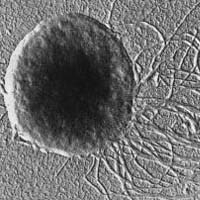 |
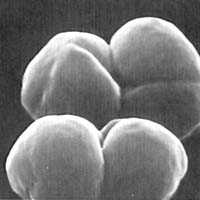 |
 |
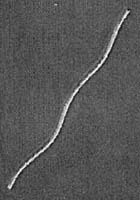 |
Basic Archaeal Shapes : At far left, Methanococcus janaschii, a coccus form with numerous flagella attached to one side. At left center, Methanosarcina barkeri, a lobed coccus form lacking flagella. At right center, Methanothermus fervidus, a short bacillus form without flagella. At far right, Methanobacterium thermoautotrophicum, an elongate bacillus form.
Structural diversity among archaeans is not limited to the overall shape of the cell. Archaea may have one or more flagella attached to them, or may lack flagella altogether. The flagella are hair-like appendages used for moving around, and are attached directly into the outer membrane of the cell. When multiple flagella are present, they are usually attached all on one side of the cell. Other appendages include protein networks to which the cells may anchor themselves in large groups.
Like bacteria, archaeans have no internal membranes and their DNA exists as a single loop called a plasmid. However, their tRNAs have a number of features that differ from all other living things. The tRNA molecules (short for "transfer RNA") are important in decoding the message of DNA and in building proteins. Certain features of tRNA structure are the same in bacteria, plants, animals, fungi, and all known living things -- except the Archaea. There are even features of archaeal tRNA that are more like eukaryotic critters than bacteria, meaning that Archaea share certain features in common with you and not with bacteria. The same is true of their ribosomes, the giant processing molecules that assemble proteins for the cell. While bacterial ribosomes are sensitive to certain chemical inhibiting agents, archaeal and eukaryotic ribosomes are not sensitive to those agents. This may suggest a close relationship between Archaea and eukaryotes.
As with other living things, archaeal cells have an outer cell membrane that serves as a barrier between the cell and its environment. Within the membrane is the cytoplasm, where the living functions of the archeon take place and where the DNA is located. Around the outside of nearly all archaeal cells is a cell wall, a semi-rigid layer that helps the cell maintain its shape and chemical equilibrium. All three of these regions may be distinguished in the cells of bacteria and most other living things, but when you take a closer look at each region, you find that the similarities are merely structural, not chemical.
In other words, Archaea build the same structures as other organisms, but they build them from different chemical components. For instance, the cell walls of all bacteria contain the chemical peptidoglycan. Archaeal cell walls do not contain this compound, though some species contain a similar one. Likewise, archaea do not produce walls of cellulose (as do plants) or chitin (as do fungi). The cell wall of archaeans is chemically distinct.
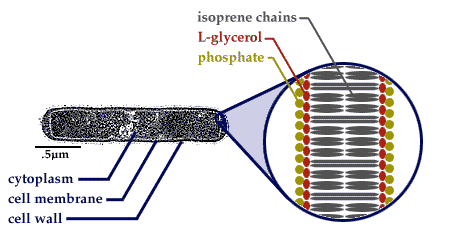
Basic Archaeal Structure : The three primary regions of an archaeal cell are the cytoplasm, cell membrane, and cell wall. Above, these three regions are labelled, with an enlargement at right of the cell membrane structure. Archaeal cell membranes are chemically different from all other living things, including a "backwards" glycerol molecule and isoprene derivatives in place of fatty acids. See text below for details.
The most striking chemical differences between Archaea and other living things lie in their cell membrane. Their are four fundamental differences between the archaeal membrane and those of all other cells: (1) chirality of glycerol, (2) ether linkage, (3) isoprenoid chains, and (4) branching of side chains. These may sound like complex differences, but a little explanation will make the differences understandable. The header for each explanation is color-coded to match the relevant portion of the diagram below.
(1) Chirality of glycerol : The basic unit from which cell membranes are built is the phospholipid. This is a molecule of glycerol which has a phosphate added to one end, and two side chains attached at the other end. When the cell membrane is put together, the glycerol and phosphate end of the molecules hang out at the surface of the membrane, with the long side chains sandwiched in the middle (see illustration above). This layering creates an effective chemical barrier around the cell and helps maintain chemical equilibrium.
The glycerol used to make archaeal phospholipids is a stereoisomer of the glycerol used to build bacterial and eukaryotic membranes. Two molecules that are stereoisomers are mirror-images of each other. Put your hands out in front of you, palms up. Both hands are oriented with fingers pointing away from you, wrists toward you, and with palms upwards. However, your thumbs are pointing different directions because each hand is a mirror image of the other. If you turn one hand so that both thumbs point the same way, that one will no longer be palm-up.
This is the same situation as the stereoisomers of glycerol. There are two possible forms of the molecule that are mirror images of each other. It is not possible to turn one into the other simply by rotating it around. While bacteria and eukaryotes have D-glycerol in their membranes, archaeans have L-glycerol in theirs. This is more than a geometric difference. Chemical components of the cell have to be built by enzymes, and the "handedness" (chirality) of the molecule is determined by the shape of those enzymes. A cell that builds one form will not be able to build the other form.
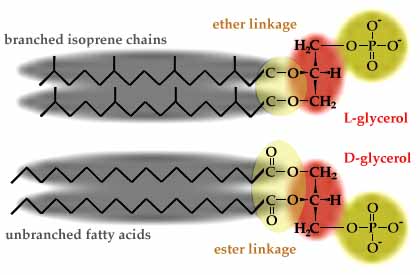
(2) Ether linkage : When side chains are added to the glycerol, most organisms bind them together using an ester linkage (see diagram above). The side chain that is added has two oxygen atoms attched to one end. One of these oxygen atoms is used to form the link with the glycerol, and the other protrudes to the side when the bonding is done. By contrast, archaeal side chains are bound using an ether linkage, which lacks that additional protruding oxygen atom. This gives the resulting phospholipid different chemical proerties from the membrane lipids of other organisms.
(3) Isoprenoid chains : The side chains in the phospholipids of bacteria and eukaryotes are fatty acids, chains of usually 16 to 18 carbon atoms. Archaea do not use fatty acids to build their membrane phospholipids. Instead, they have side chains of 20 carbon atoms built from isoprene.
Isoprene is the simplest member of a class of chemicals called terpenes. By definition, a terpene is any molecule bilt by connecting isoprene molecules together, rather like building with Lego® blocks. Each isoprene unit has a "head" and a "tail" end (again like a Lego® block), but unlike their toy counterparts, isoprene blocks can be joined in many ways. A head can be attached to a tail or to another head end, and tails can be similarly joined. The immense variety of terpene compounds that can be built from simple isoprene units include beta-carotene (a vitamin), natural and synthetic rubbers, plant essential oils (such as spearmint), and steroid hormones (such as estrogen and testosterone).
(4) Branching of side chains : Not only are the side chains of achaeal membranes built from different components, but the chains themselves have a different physical structure. Because isoprene is used to build the side chains, there are side branches off the main chain (see diagram above). The fatty acids of bacteria and eukaryotes do note have these side branches (the best they can manage is a slight bend in the middle), and this creates some interesting properties in archaeal membranes.
For example, the isoprene side chains can be joined together. This can mean that the two side chains of a single phospholipid can join together, or they can be joined to side chains of another phospholipid on the other side of the membrane. No other group of organisms can form such transmembrane phospholipids.
Another interesting property of the side branches is their ability to form carbon rings. This happens when one of the side branches curls around and bonds with another atom down the chain to make a ring of five carbon atoms. Such rings are thought to provide structural stability to the membrane, since they seem to be more common among species that live at high temperatures. They may work in the same way that cholesterol does in eukaryotic cells to stabilize membranes. It's interesting to note that cholesterol is another terpene!
For more information :

Sources:

